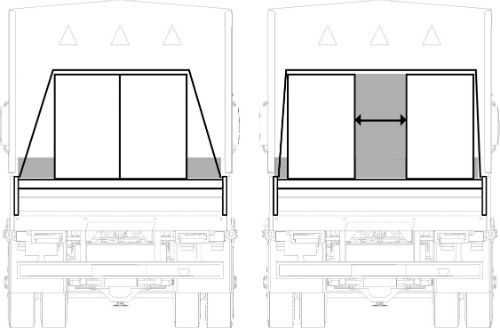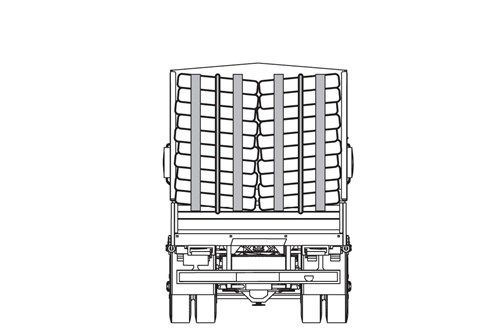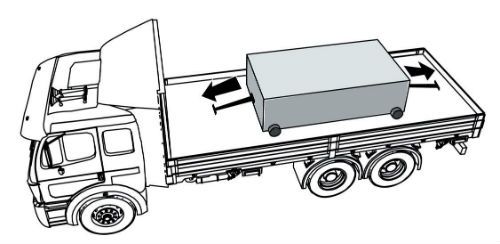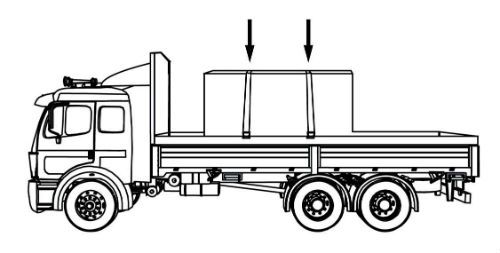CDL Practice Tests: Flatbed Cargo Securement
Choose A Section:
Go!Which of the following is not a method of securing side-by-side cargo?
- Use some kind of blocking to prevent shifting.
- Fill the empty space between with other cargo.
- Place them in direct contact with each other.
- Make sure it is leaning forward.
For articles of cargo placed beside each other and secured by side-to-side tiedowns:

Either place them in direct contact with each other,
Or prevent them from shifting towards each other in transit by using blocking or filling the space with other cargo.
In cargo securement, what is a 'cleat' defined as?
- A tapered or wedge-shaped piece used to secure round articles against rolling.
- A tapered piece of material, thick at one end and thin at the other.
- A short piece of material, usually wood, nailed to the deck to reinforce blocking.
- Part of the structure, fitting, or attachment on a vehicle or cargo to which a tiedown is attached.
Cleat:
A short piece of material, usually wood, nailed to the deck to reinforce blocking.
Which of the following is not an acceptable method of containing loose parts when securing flattened or crushed vehicles?
- Wedge them in between the flattened cars.
- Sideboards or sides.
- Suitable covering material.
- Structural walls.
Containing Loose Parts
Use a containment system that:
- Prevents loose parts from falling from all four sides of the vehicle AND
- Extends to the full height of the cargo.
The containment system can consist of one or a combination of the following methods.
- Structural walls.
- Sides or sideboards.
- Suitable covering material.
The use of synthetic material for containment of loose parts is permitted.
When a tiedown is attached directly to the cargo, what is the ideal angle where it attached to the vehicle?
- 90 degrees.
- Between 45 and 60 degrees.
- Less than 45 degrees.
- It doesn't matter.
The angle where the tiedown attaches to the vehicle should be shallow, not deep (ideally less than 45).
The term 'edge protector' refers to:
- A rail along the side of a vehicle that protects the side of the vehicle from impacts.
- A device placed on the exposed edge of an article to distribute tiedown forces over a larger area of cargo than the tiedown itself, to protect the tie-down and/or cargo from damage, and to allow the tiedown to slide freely when being tensioned.
- A structure, device, or another substantial article placed against an article to prevent it from tipping that may also prevent it from shifting.
- A vertical barrier placed directly behind the cab of a tractor to protect the cab in the event cargo should shift forward.
Edge protector:
A device placed on the exposed edge of an article to distribute tiedown forces over a larger area of cargo than the tiedown itself, to protect the tie-down and/or cargo from damage, and to allow the tiedown to slide freely when being tensioned.
When securing a single metal coil with eyes vertical:
- Attach at least one tiedown over eye of coil from side-to-side.
- Attach at least one tiedown diagonally across eye of coil from right side of vehicle to left side of vehicle.
- These are all requirements.
- Attach at least one tiedown diagonally across eye of coil from left side of vehicle to right side of vehicle.
To prevent the coil from tipping forward, rearward, and sideways, arrange tiedowns to include the following:
- Attach at least one tiedown diagonally across eye of coil from left side of vehicle to right side of vehicle.
- Attach at least one tiedown diagonally across eye of coil from right side of vehicle to left side of vehicle.
- Attach at least one tiedown over eye of coil from side-to-side.
The definition for "shortwood" identifies pieces that are no longer than:
- 75 in
- 16 ft
- Half the length of the trailer.
- The width of the road.
Shortwood
- Normally up to about 2.5 m (100 in) in length.
- No longer than 4.9 m (16 ft) in length.
-
Also called:
- Cut-up logs
- Cut-to-length logs
- Bolts
- Pulpwood
When securing flattened or crushed cars on a vehicle with containment on 2 sides, how many tiedowns, at minimum, are required?
- 1
- 2
- 4
- 3
Option 3:
Has containment walls on two sides that:
- Extend to the full height of the load.
- Block against cargo movement in the forward and rearward.
Secures each stack of vehicles with a minimum of three tiedowns, each having a minimum WLL of 2,268 kg (5,000 lb.).
What is the Aggregate WLL of the securement system for a load secured with 7 tiedowns: 3 rated at WLL of 4,000 lbs, 2 at 6,500, and 1 at 8,000?
- 33,000 lbs
- 10,000 lbs
- 8,250 lbs
- 16,500 lbs
How do you calculate Aggregate Working Load Limit for tiedowns?
To calculate Aggregate Working Load limit, add together:
- 50% of the WLL of each end section of a tiedown that is attached to an anchor point.
- 50% of the WLL of each end section that is attached to the cargo
Requirements for securing two stacks of shortwood loaded side-by-side include:
- All of these are required.
- There is no space between the stacks of logs.
- The highest log is no more than 8 ft above the deck.
- At least one tiedown is used lengthwise across each stack.
Additional requirements securement for two stacks side-by-side
In addition to the requirements for shortwood loaded crosswise, load two stacks side-by-side so that:

- There is no space between the stacks of logs.
- The outside of each stack is raised at least 2.5 cm (1 in) within 10 cm (4 in) of the end of the logs or from the side of the vehicle.
- The highest log is no more than 2.44 m (8 ft) above the deck.
- At least one tiedown is used lengthwise across each stack.
About The Flatbed Cargo Securement CDL Manual
Studying the flatbed cargo securement CDL manual is not a requirement for getting your CDL permit or license. It is required knowledge for flatbed drivers.
Some questions you should be able to answer for flatbed cargo securement:
- What is the minimum Working Load Limit of a tiedown used to secure logs?
- What is the minimum weight of a shipment of paper rolls that would require specific securement requirements?
- When securing concrete pipe over 45 inches loaded crosswise, which direction must the tiedowns on the front half of the load run?
- What is a cab shield?
- When securing concrete pipe over 45 inches loaded crosswise, which direction must the tiedowns on the rear half of the load run?
- What is a dunnage bag?
- Who is responsible for inspecting securing devices and cargo within the first 50 miles?
- How many tiedowns are required on a stack of shortwood loaded crosswise?
- What is the minimum working load limit of each tiedown used to secure crushed or flattened vehicles?
- Define 'bolster'
- What is a hook-lift container?
- When a tiedown is attached directly to the cargo, what is the ideal angle where it attached to the vehicle?
What is a securing device?
Any device specifically manufactured to attach or secure cargo to a vehicle or trailer:
- Synthetic Webbing
- Chain
- Wire rope
- Manila rope
- Synthetic rope
- Steel strapping
- Clamps and latches
- Blocking
- Front-end structure
- Grab hooks
- Binders
- Shackles
- Winches
- Stake pockets
- D-rings
- Webbing ratchet
- Bracing
- Friction mat
What is a tiedown?
A combination of securing devices that forms an assembly that:
- Attaches cargo to, or restrains cargo on a vehicle.
- Is attached to anchor point(s).

Some tiedowns are attached to the cargo and provide direct resistance to restrain the cargo from movement.

Some tie-downs pass over or through the cargo. They create a downward force that increases the effect of friction between the cargo and the deck. This friction restrains the cargo.
 Related Cargo Securement Terms That Every Driver Should Know:
Related Cargo Securement Terms That Every Driver Should Know:
-
Tiedown:
A combination of securing devices which form an assembly that attaches cargo to, or restrains cargo on, a vehicle or trailer, and is attached to anchor point(s).
-
Contained:
Cargo is contained if it fills a sided vehicle, and every article is in contact with or sufficiently close to a wall or other articles so that it cannot shift or tip if those other articles are also unable to shift or tip.
-
Blocking:
A structure, device, or another substantial article placed against or around an article to prevent horizontal movement of the article.
How should tiedowns be attached?
Tiedowns can be used in two ways:
-
Attached to the cargo:
- Tiedowns attached to the vehicle and attached to the cargo.
- Tiedowns attached to the vehicle, pass through or aroundan article of cargo, and then are attached to the vehicle again.
-
Pass over the cargo:
- Tiedowns attached to the vehicle, passed over the cargo, and then attached to the vehicle again.
Tiedown placement:

Place the tiedown as close as possible to the spacer.
Position the tiedowns as symetrically as possible over the length of the article.

Position the tiedowns to preserve the integrity of the article.







 TT On Facebook
TT On Facebook